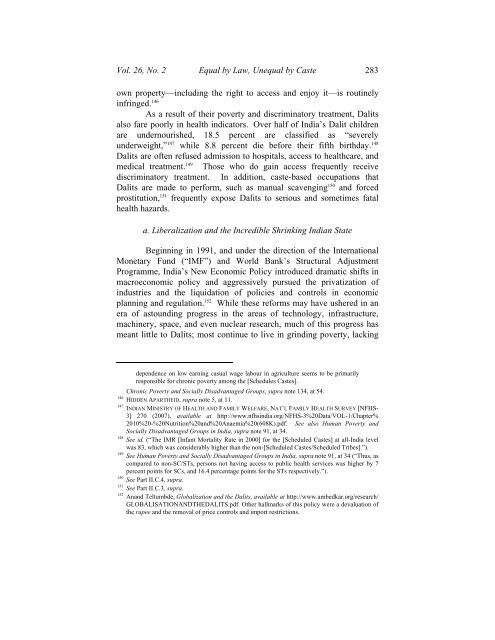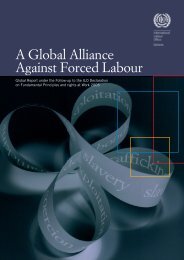equal by law, unequal by caste - International Dalit Solidarity Network
equal by law, unequal by caste - International Dalit Solidarity Network
equal by law, unequal by caste - International Dalit Solidarity Network
Create successful ePaper yourself
Turn your PDF publications into a flip-book with our unique Google optimized e-Paper software.
Vol. 26, No. 2 Equal <strong>by</strong> Law, Un<strong>equal</strong> <strong>by</strong> Caste 283own property—including the right to access and enjoy it—is routinelyinfringed. 146As a result of their poverty and discriminatory treatment, <strong>Dalit</strong>salso fare poorly in health indicators. Over half of India’s <strong>Dalit</strong> childrenare undernourished, 18.5 percent are classified as “severelyunderweight,” 147 while 8.8 percent die before their fifth birthday. 148<strong>Dalit</strong>s are often refused admission to hospitals, access to healthcare, andmedical treatment. 149 Those who do gain access frequently receivediscriminatory treatment. In addition, <strong>caste</strong>-based occupations that<strong>Dalit</strong>s are made to perform, such as manual scavenging 150 and forcedprostitution, 151 frequently expose <strong>Dalit</strong>s to serious and sometimes fatalhealth hazards.a. Liberalization and the Incredible Shrinking Indian StateBeginning in 1991, and under the direction of the <strong>International</strong>Monetary Fund (“IMF”) and World Bank’s Structural AdjustmentProgramme, India’s New Economic Policy introduced dramatic shifts inmacroeconomic policy and aggressively pursued the privatization ofindustries and the liquidation of policies and controls in economicplanning and regulation. 152 While these reforms may have ushered in anera of astounding progress in the areas of technology, infrastructure,machinery, space, and even nuclear research, much of this progress hasmeant little to <strong>Dalit</strong>s; most continue to live in grinding poverty, lackingdependence on low earning casual wage labour in agriculture seems to be primarilyresponsible for chronic poverty among the [Schedules Castes].Chronic Poverty and Socially Disadvantaged Groups, supra note 134, at 54.146 HIDDEN APARTHEID, supra note 5, at 11.147 INDIAN MINISTRY OF HEALTH AND FAMILY WELFARE, NAT’L FAMILY HEALTH SURVEY [NFHS-3] 270 (2007), available at http://www.nfhsindia.org/NFHS-3%20Data/VOL-1/Chapter%2010%20-%20Nutrition%20and%20Anaemia%20(608K).pdf. See also Human Poverty andSocially Disadvantaged Groups in India, supra note 91, at 34.148 See id. (“The IMR [Infant Mortality Rate in 2000] for the [Scheduled Castes] at all-India levelwas 83, which was considerably higher than the non-[Scheduled Castes/Scheduled Tribes].”).149 See Human Poverty and Socially Disadvantaged Groups in India, supra note 91, at 34 (“Thus, ascompared to non-SC/STs, persons not having access to public health services was higher <strong>by</strong> 7percent points for SCs, and 16.4 percentage points for the STs respectively.”).150 See Part II.C.4, supra.151 See Part II.C.3, supra.152 Anand Teltumbde, Globalization and the <strong>Dalit</strong>s, available at http://www.ambedkar.org/research/GLOBALISATIONANDTHEDALITS.pdf. Other hallmarks of this policy were a devaluation ofthe rupee and the removal of price controls and import restrictions.
















